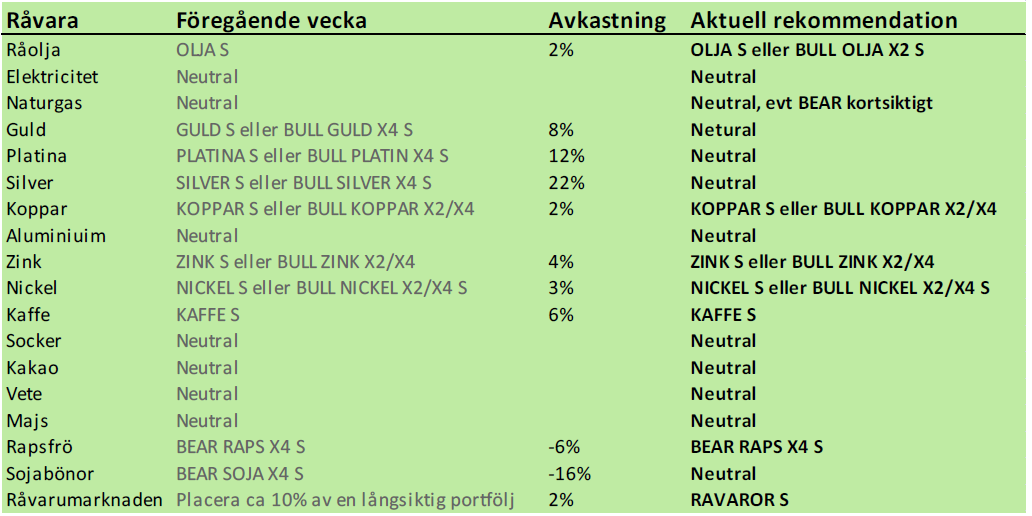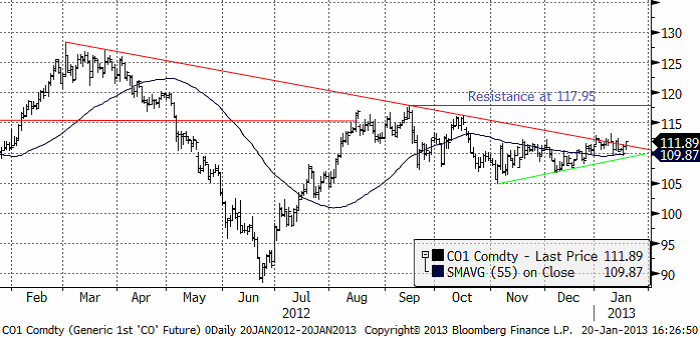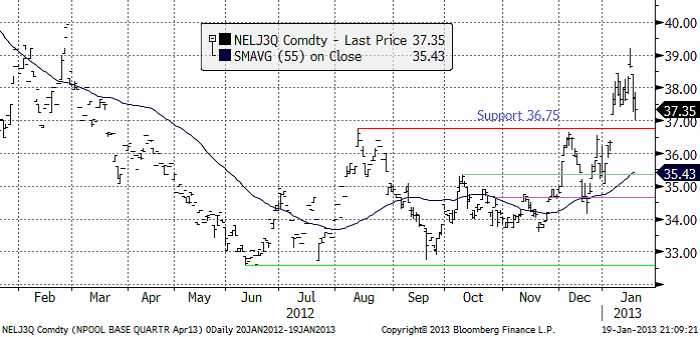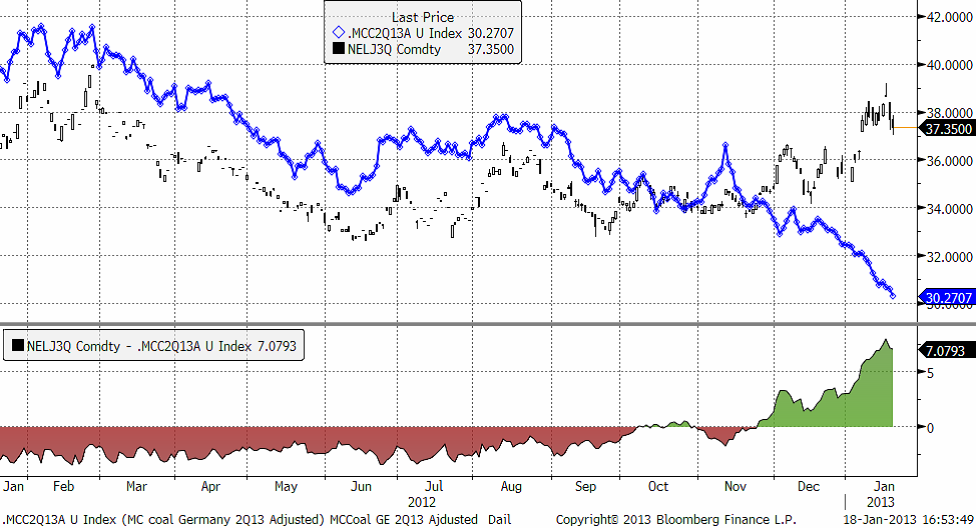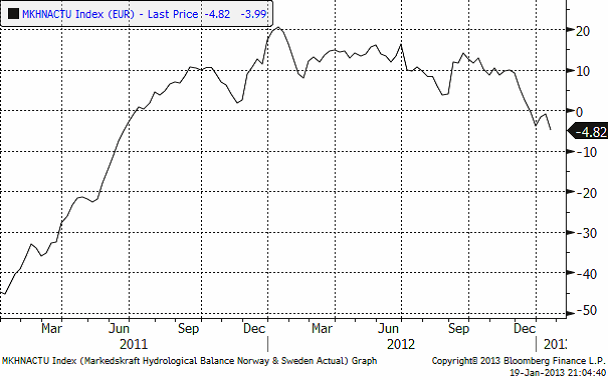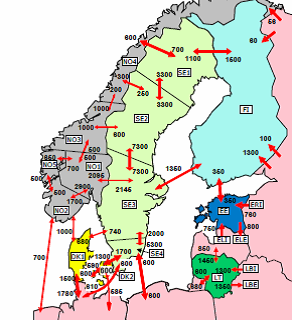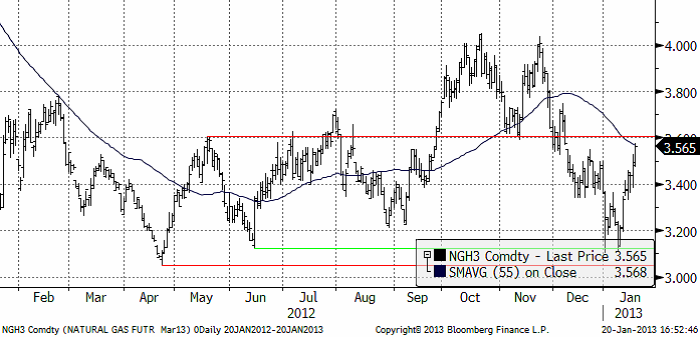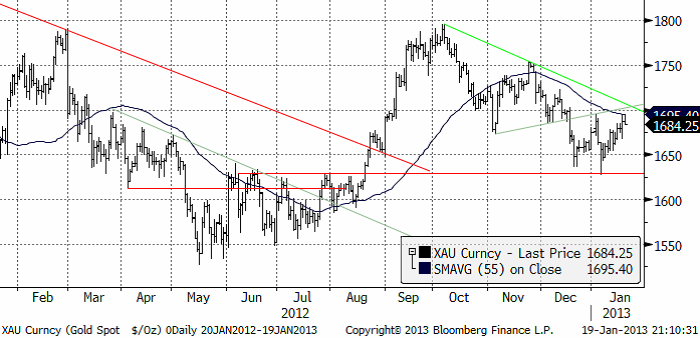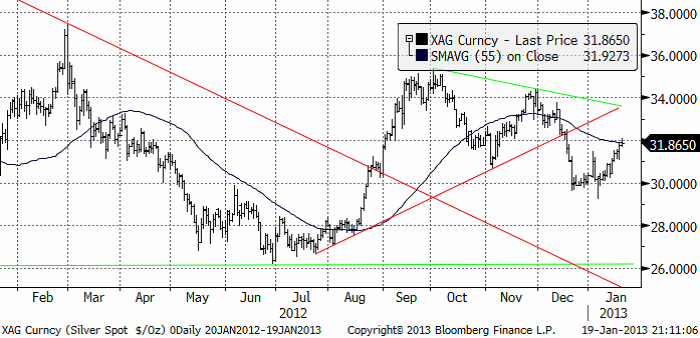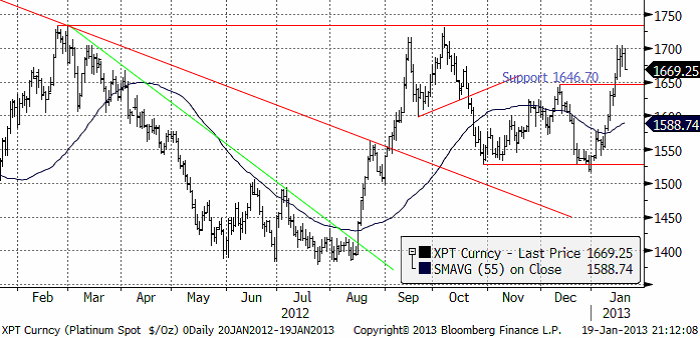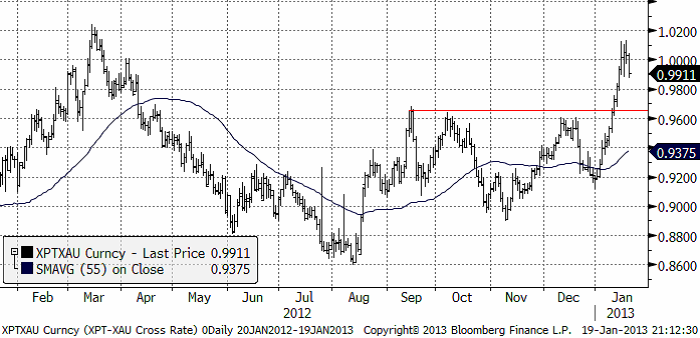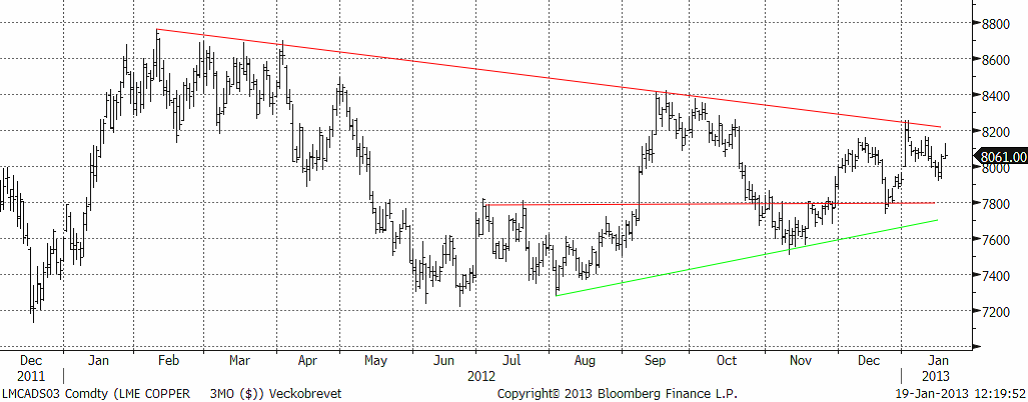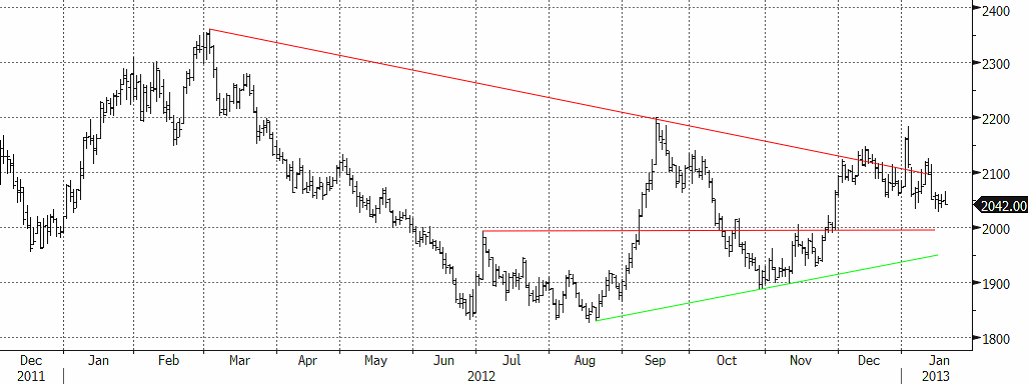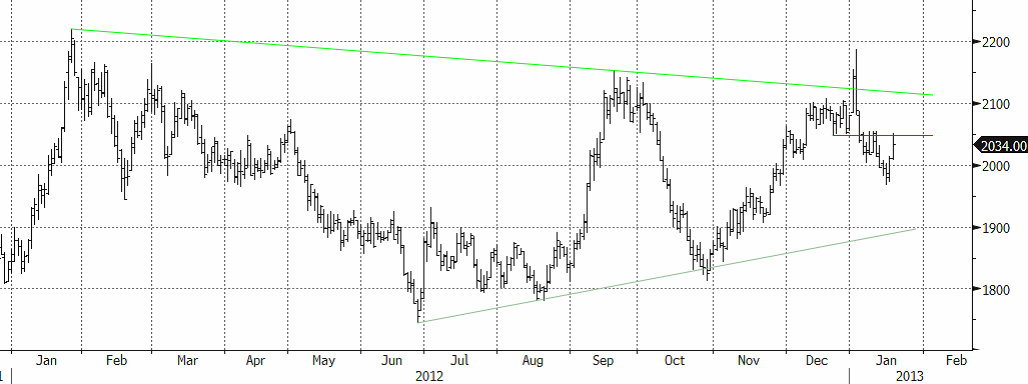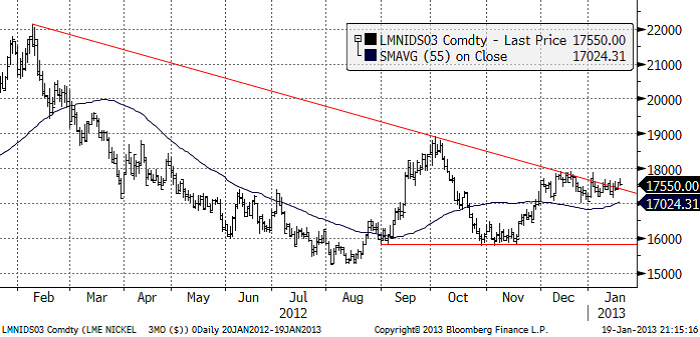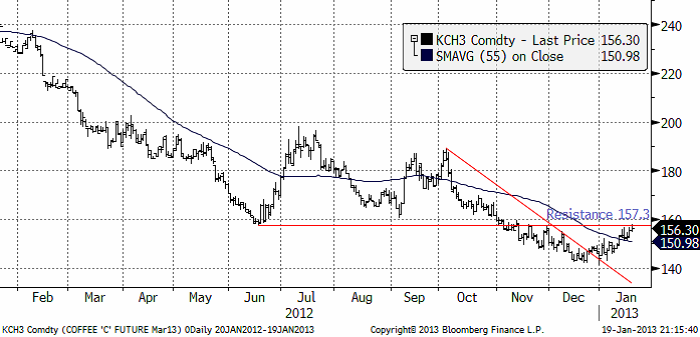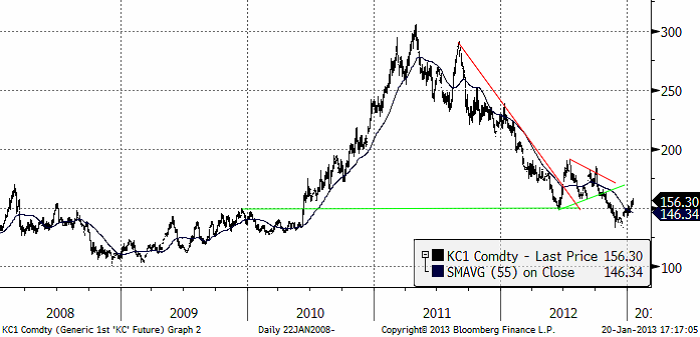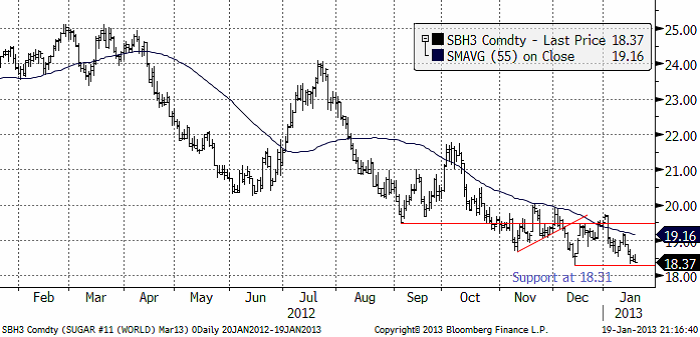Analys
SEB – Råvarukommentarer, 21 januari 2013
Rekommendationer
Inledning
SEB:s råvaruindex var oförändrat i veckan som gick. Däremot steg dollarn, vilket medförde att certifikatet RAVAROR S, som följer indexet, steg med 2%.
Till vinnarna i veckan hörde platina (igen), silver och guld, även kaffe utvecklades väl: alla dessa helt i linje med våra rekommendationer. Elpriset steg i början på veckan, men föll sedan ganska kraftigt i pris. Vi tycker att man ska avvakta med köp av EL S eller BULL EL X2/X4 S, då priset kanske kommer ner ytterligare lite grand innan marknaden vänder. Nästa vecka kanske tiden är mogen för gå in på långa sidan igen.
Ädelmetallerna har alla nått upp till kritiska nivåer och tekniskt är risken överhängande att rekylen uppåt den senaste tiden, övergår i fallande pris igen. Vi tar därför hem vinsterna på långa positioner i ädelmetaller och gör i första hand över till neutral rekommendation.
Vi ändrar rekommendationen att ligga kort sojabönor. Tekniskt är läget svårtolkat och vi måste gå över till neutralt läge.
Kanske kommer det ny information i veckan som ger vägledning om trenden framöver. Raps är relaterat till sojabönorna. Där är det också sidledes rörelse, men man kan fortfarande betrakta trenden nedåt som obruten.
På oljemarknaden börjar det hända saker, efter att Saudiarabien minskat produktionen och den globala konjunkturen följer en dynamik som stämmer överens med “sen recession”. Detta gör också basmetallerna intressanta på uppsidan.
Råolja – Brent
International Energy Agency, köparländernas motpol till OPEC publicerade sin månadsrapport i fredags. IEA förutspår mindre utbud i förhållande till efterfrågan under året. Global oljefterfrågan väntas stiga med 1% till 90.8 miljoner fat om dagen. Utbudet växer snabbare från länder utanför OPEC och den tillväxten väntas öka till den högsta takten sedan 2012, men amerikanska exportbegränsningar kan begränsa tillväxten i amerikansk produktion. OPEC:s decemberproduktion föll till lägsta nivån under 2012, efter att Saudiarabien dragit ner produktionen. OPEC:s decemberproduktion föll till 30.65 mb/d.
Priset på råolja fortsätter att röra sig inom ett snävt prisintervall. Hittills i år har 110 dollar utgjort ett golv. På den övre sidan av intervallet har 113 dollar varit ett motstånd. Goldman Sachs förvånade alla i veckan som gick genom att förutspå 150 dollar / fat. Motivet var Iran och spridningen av den arabiska våren.
Tekniskt ser vi att en triangelformation bildats och den tycks brytas på uppsidan. På kort sikt finns det då potential upp mot motståndet på 117.95.
Nedan ser vi den veckovisa lagerstatistiken från USA. Lagren av heating oil minskade rätt så mycket och ligger också långt under förra årets nivå. Råoljelagren minskade också enligt DOE, men ligger nästan 10% över förra årets nivå.
Det ser alltså ut att hända saker på oljemarknaden. Månader av sidledes rörelse kan vara över. Utöver att bara vara köpt OLJA S och tjäna in rabatten på oljan i terminsmarknaden på +6% per år, tror vi att det kan komma en uppgång som motiverar ett köp av t ex BULL OLJA X2 S.
Elektricitet
Elpriset, för det andra kvartalet, reagerade något ologiskt på kyla just nu i Norden och gick upp och noterade det högsta priset på ett år. Det är påverkan på den hydrologiska balansen som dragit upp priset. Euforin blev dock kortvarig och rörelsen på dagen liknar en ”key reversal day”. En sådan signalerar trendvändning. Nedåt i det här fallet. Stöd finns nu på 36.75 och så som priset faller nu kan den stödnivån mycket väl komma att brytas.
Nedan ser vi terminspriset för andra kvartalet och marginalkostnaden för att producera elektricitet med kol, i euro per MWh. På lång sikt är det marginalkostnaden för kolkraft som styr elpriset i Sverige. Vatten- och kärnkraft räcker inte till och då är det kol som styr vid den konsumtion vi ligger på idag (och konsumtionen har varit ungefär på konstant nivå de senaste åren). Vi ser att kolkraften fortsatt att falla i kostnad och gapet är förvånande stort.
Vad gäller vädret så ser det idag ut som högryckscenariet kommer fortsätta dominera. De första 5 dygnen är säkra medan dygn 6-10 indikerar samma vädertyp.
Vad gäller spotpriset är det ca 41 för måndag, ca 5 eur lägre än förra måndagen och väsentligt under förra veckans högsta på 53.5. Orsaken är att det är lite mindre kallt och verkar bli rejält blåsigt i Danmark.
Den hydrogiska balansen har dock fortsatt att falla. Markedskraft publicerar statistik på den hydrologiska balansen för Norge och Sverige. Den anges i TWh kraft som finns lagrat i vatten som kan passera ett vattenkraftverk. I diagrammet nedan visas hur mycket mer / mindre som finns i förhållande till vad som är normalt. Och med normalt avses genomsnittet för respektive dag på året mellan 1962 och 2006. Sedan förra veckan har underskottet ökat med 4 TWh till -5TWh.
Med nuvarande väderleksprognoser är visar den hydrologiska balansen ett underskott på hela -11 TWh om en dryg månad!
Överföringskapacitet till utanför elbörsområdet ser vi i kartan nedan. Siffrorna anger överföringskapaciteten i MW.
Vi rekommenderar att man håller sig borta från BULL EL – varianter och inväntar bättre priser att senare komma in på den långa sidan.
Naturgas
Naturgasterminen på NYMEX (mars 2013) har stigit mycket kraftigt och är uppe vid motståndet på 3.60 dollar per MMBtu. NOAA har släppt en långtidsprognos som visar att varmare väder än normalt i USA kommer att dröja sig kvar ända till sommaren. Det finns nu alltså både tekniska och fundamentala anledningar att tro att prisuppgången kan brytas vid den här nivån.
Den som kortsiktigt vill prova på att handla naturgas, kan kanske försöka sig på ett mycket kortsiktigt inhopp i BEAR NATGAS X4 S. På längre sikt tror vi att man bör vara neutral.
Guld och Silver
Tekniskt är priset på guld i dollar uppe vid utbrottsnivån från triangelformationen vi skrivit om tidigare. Det är vanligt att rekyler, som jag tror det här handlar om, når upp till utbrottsnivån för att sedan vända nedåt igen.
Det finns mycket fundamentalt i ekonomin som talar för guld. En fortsättning på det amerikanska QE3 ligger inte långt borta.
Japan har lämnat sitt velande och slagit in på en politik att försöka devalvera sin valuta genom att trycka ännu mer yen. Detta lär sprida sig till andra länder, som kan komma att tävla om att devalvera sina valutor för att hjälpa sin egen inhemska ekonomi. De enda som står fast då bland ”valutorna” är ädelmetallerna. Men just nu, ser den tekniska bilden alltså inte särskilt positiv ut.
Nedan ser vi kursdiagrammet för silver i dollar per troy ounce. Situationen är snarlik den för guld. Priset är uppe vid motståndsnivån 32 dollar. En rekyl nedåt i veckan tror vi har hög sannolikhet att inträffa.
Platina
Platina, vår favorit bland de tre ädelmetallerna, har gått upp rejält i veckan som gick, men priset föll oroväckande i fredags. Priset lyckades inte nå över 1700 dollar och inte heller nå toppnoteringarna från februari och oktober förra året. En rekyl nedåt förefaller trolig.
Nedan ser vi priset på platina i termer av guld, eller ”växelkursen” mellan XPT och XAU, valutakoderna för de två ädelmetallerna. Den här kvoten nådde förra årets toppnivåer i veckan som gick. Efter en god resa uppåt hittills i år, kan det kanske vara dags för vinsthemtagningar, tänker vi.
Vi rekommenderar alltså att man kortsiktigt kliver ur långa positioner i ädelmetaller. Kortsiktigt kan man eventuellt ta position i BEAR-varianter på guld, silver eller platina.
Basmetaller
Veckan inleddes med få prispåverkande nyheter med allmänt avvaktande aktörer, vilket ledde till svagt sjunkande priser. Fokus låg på torsdagens amerikanska makrodata och senare nattens BNP och övrig industridata från Kina. Amerikansk byggstartsdata överraskade (+12.1 % i december) och startade ett rally på de finansiella marknaderna vilket drog med sig metallerna uppåt. Kinasiffrorna kom in något bättre än väntat. BNP-tillväxten under Q4 kom in på 7,9 %, den första accelerationen på åtta månader. Industriproduktionen i december steg 10,3 %, någon tiondel bättre än väntat.
Basmetallerna återhämtade fallet tidigare i veckan och stänger kring nollstrecket. Risken är att marknaden på kort sikt förblir något avvaktande, nu med sikte på mer vägledning kring aktiviteten i den kinesiska ekonomin, inför det kinesiska nyårsfirandet mellan 9-15:e februari. Förhandlingarna kring det amerikanska skuldtaket kommer också skapa osäkerhet. Utveckling så här långt i år är i stort sett plus minus noll för basmetallerna. Vi kvarstår med bedömningen att nedsidorna är begränsade och med hjälp av det säsongsmässigt starka Q1 finns goda förutsättningar för prisuppgångar på 3-4 månaders sikt. Som tidigare skrivits, föredrar vi i detta sammanhang, nickel och zink.
Koppar
Koppar ledde prisuppgången under veckans avslutning. Den amerikanska byggstartsstatistiken (Housing Starts) är en traditionell ”kopparsiffra”, vilket gav en extra stimulans. Marknaden dämpas av känslan att tillväxten av Kinas kopparimport är avtagande, vilket i sig inte behöver betyda minskad efterfrågan i Kina. Flera bedömare tror nu att de kommer fortsätta beta av inhemska lager och importökning först kommer lite senare under året, såvida inte LME-priset faller kraftigt, då kineserna ofta agerar utifrån prisnivån Den tekniska bilden är relativt neutral för tillfället. Om LME-noteringen (3 månaders) kommer ned mot $7800 är det ett köp.
Alternativet är att avvakta ett brott på uppsidan kring $8200 (över trendlinjen), alternativt $8400 (toppen från september).
Aluminium
Aluminium följde inte riktigt med den allmända trenden och lyckades inte under veckans avslutning återhämta förlorad mark i samma utsträckning som övriga basmetaller. Aktörerna fokuserar på terminskurvan och den LME-relaterade kortheten från december förra året, som nu flyttats ”längre ut på kurvan”. Normalt rullas positioner 3 månader framåt vilket skulle innebära en stram marknad i mars. Nu är det istället juni som börjar bli tight. Någon eller några stora aktörer sitter på korta positioner som rullas framåt. Marknadskällor gör gällande att positioner flyttas ända ut till 2014 vilket återspeglas i en lägre contango (terminspremie) t.ex. perioden dec13-dec14. Ur ett investeringsperspektiv gör det marknaden ovanligt svåranalyserad. Rent fundamentalt är efterfrågeutsikterna väldigt goda med positiva rapporter vad gäller efterfrågan från framför allt bil- och flygindustrin. Det som gör oss tveksamma för uppsidan är en fortsatt ökande produktion, och det kan dröja 1-2 år innan marknaden är i balans.
Veckans utveckling plockar ned priset tillbaka i den sidledes trenden. Stöd kommer att infinna sig kring $2000 i första läget.
Zink
Som vi nämnt tidigare har zinken fått lida av omviktning av råvaruindex. Stora volymer skulle säljas (enligt rykten ca 13 000 LME-kontrakt, vilket är ganska mycket för zink). Effekten borde nu ha avtagit. Som vi skrivit tidigare är de största användningsområdena för zink bygg- och transportindustrin. Två områden som nu gynnas av en mer positivt syn på tillväxten i Kina och USA. Zink ligger väl placerad i det scenariot.
Den mer positiva utvecklingen under veckans avslutning fick zinken att sluta veckan på plus med ca 1 %. Tekniskt sett nivån $2050 viktig. På vägen ned fungerade det som stöd, nu får motsatt effekt när priset börjat klättra igen. Ett genombrott öppnar för en kortsiktig uppgång till nivåer strax över $2100. I perspektivet 3-4 månader är vi fortsatt positiva.
Vi rekommenderar köp av ZINK S eller BULL ZINK X2 / X4 S för den som vill ta mer risk. Man bör gå ur positionen om priset faller genom 1930 dollar per ton, som är stödet i den konsolideringsfas som varit rådande sedan prisfallet slutade i slutet av maj. Kortsiktigt bör man ta hem vinst vid motståndsnivån $2150. På lite längre sikt är potentialen större. Nästa motståndsnivå kommer in vid $2200, men målet är $2400 på 2- 3 månaders sikt.
Nickel
De senaste fundamentala rapporter vi tagit del av tyder på en marknad i balans under Q1 2013, detta tack vare att vi är inne i den säsongsmässigt starka perioden. Studier som genomförts styrker vår anekdotiska erfarenhet att perioden nov-april brukar innebära ökad efterfrågan (och stigande nickelpris). Problemet just nu är att utbudet är lite för överhängande för att ge tillräcklig hävstång på priset. Nickel kan dock erfarenhetsmässigt ofta överraska med sin prisrörlighet. Den tekniska bilden ser generellt positiv ut med en tendens till ”högre bottnar”. Det blir viktigt hur marknaden beter sig i intervallet $17000 och $18000 ($17550 i skrivandes stund). Det viktigt att den nedre nivån håller för att hålla uppe tempot. Bryter det på uppsidan kan det ta fart ordentligt på uppsidan.
Vi rekommenderar köp av NICKEL S eller BULL NICKEL X2 / X4 S för den som vill ta mer risk. Man bör gå ur positionen om priset faller genom 15,800 dollar per ton, som är stödet i den konsolideringsfas som varit rådande sedan prisfallet slutade i slutet av oktober. Kortsiktigt bör man ta hem vinst vid moståndsnivån $18000. På lite längre sikt är potentialen större. Nästa motståndsnivå kommer in strax under $19000.
Kaffe
De som köpte KAFFE S förra veckan har gjort en bra affär. I fredags stängde priset precis under det viktiga motståndet 157.35 cent per pund. Den observante konsumenten har noterat att kaffe reas ut i dagligvaruhandeln (”3 för 50 kr”). Antagligen säljer de stora mängder. Eventuellt kan man ta hem vinster kortsiktigt på den här nivån och försöka komma in igen på en lite lägre nivå efter en eventuell rekyl. Men motståndet kan också brytas och i så fall bör man köpa ännu mer KAFFE S.
Om vi sätter dagens kurs i perspektiv av de senaste fem årens prisutveckling, ser vi att priser nu är nere på riktiga bottennivåer. Prisfallet från toppen är riktigt stort. Det finns stor potential på uppsidan. Vi tror att tiden är mogen för att placera i kaffe från den långa sidan och då inte bara på kort sikt. Den som har köpt sina tre paket för 50 kr, kan utöka sin position med KAFFE S.
Socker
Sockerpriset (mars 2013) är nu nere och testar botten / stödet på 18.31. I fredags stängde handeln i mars-kontraktet på 18.37 cent per pund. Trenden är alltjämt nedåtriktad. Det spännande i veckan att se, är om stödet bryts eller om priset rör sig ”sidledes” strax ovanför.
För övriga jordbruksråvaror se analysbrevet från SEB från tidigare idag.
[box]SEB Veckobrev Veckans råvarukommentar är producerat av SEB Merchant Banking och publiceras i samarbete och med tillstånd på Råvarumarknaden.se[/box]
Disclaimer
The information in this document has been compiled by SEB Merchant Banking, a division within Skandinaviska Enskilda Banken AB (publ) (“SEB”).
Opinions contained in this report represent the bank’s present opinion only and are subject to change without notice. All information contained in this report has been compiled in good faith from sources believed to be reliable. However, no representation or warranty, expressed or implied, is made with respect to the completeness or accuracy of its contents and the information is not to be relied upon as authoritative. Anyone considering taking actions based upon the content of this document is urged to base his or her investment decisions upon such investigations as he or she deems necessary. This document is being provided as information only, and no specific actions are being solicited as a result of it; to the extent permitted by law, no liability whatsoever is accepted for any direct or consequential loss arising from use of this document or its contents.
About SEB
SEB is a public company incorporated in Stockholm, Sweden, with limited liability. It is a participant at major Nordic and other European Regulated Markets and Multilateral Trading Facilities (as well as some non-European equivalent markets) for trading in financial instruments, such as markets operated by NASDAQ OMX, NYSE Euronext, London Stock Exchange, Deutsche Börse, Swiss Exchanges, Turquoise and Chi-X. SEB is authorized and regulated by Finansinspektionen in Sweden; it is authorized and subject to limited regulation by the Financial Services Authority for the conduct of designated investment business in the UK, and is subject to the provisions of relevant regulators in all other jurisdictions where SEB conducts operations. SEB Merchant Banking. All rights reserved.
Analys
Brent crude inching higher on optimism that US inflationary pressures are fading


Brent crude price inching higher on optimistic that US inflationary pressures are fading. Brent crude closed up 1.1 USD/b ydy to a close of USD 86.39/b which was the highest close since the end of April. This morning it is trading up another half percent to USD 86.9/b along with comparable gains in industrial metals and Asian equities. At 14:30 CET the US will publish its preferred inflation gauge, the PCE figure. Recent data showed softer US personal spending in Q1. Expectations are now high that the PCE inflation number for May will show fading inflationary pressures in the US economy thus lifting the probability for rate cuts later this year which of course is positive for the economy and markets in general and thus positive for oil demand and oil prices. Hopes are high for sure.
Brent crude is trading at the highest since the end of April
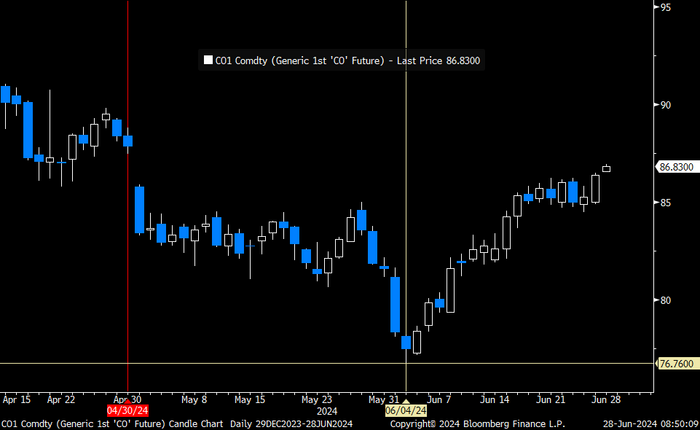
The rally in Brent crude since early June is counter to rising US oil inventories and as such a bit puzzling to the market.
US commercial crude and oil product stocks excluding SPR.

Actual US crude oil production data for April will be published later today. Zero growth in April is likely. Later today the US EIA will publish actual production data for US crude and liquids production for April. Estimates based on US DPR and DUC data indicates that there will indeed be zero growth in US crude oil production MoM in April. This will likely driving home the message that there is no growth in US crude oil production despite a Brent crude oil price of USD 83/b over the past 12 mths. The extension of this is of course rising expectations that there will be no growth in US crude oil production for the coming 12 months either as long as Brent crude hoovers around USD 85/b.
US production breaking a pattern since Jan 2014. No growth at USD 83/b. What stands out when graphing crude oil prices versus growth/decline in US crude oil production is that since January 2014 we have not seen a single month that US crude oil production is steady state or declining when the Brent crude oil price has been averaging USD 70.5/b or higher.
US Senate looking into the possibility that US shale oil producers are now colluding by holding back on investments, thus helping to keep prices leveled around USD 85/b.
Brent crude 12mth rolling average price vs 4mth/4mth change in US crude oil production. Scatter plot of data starting Jan 2014. Large red dot is if there is no change in US crude oil production from March to April. Orange dots are data since Jan 2023. The dot with ”-1.3%” is the March data point.
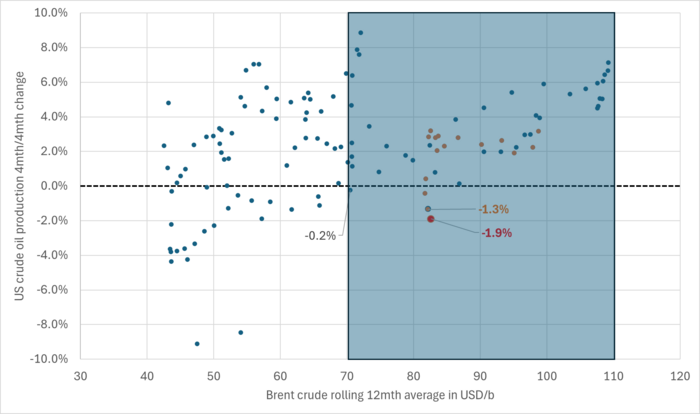
Brent crude 12mth rolling average price vs 4mth/4mth change in US crude oil production. Data starting Jan 2014. The last data point is if there is no change in US crude oil production from March to April.
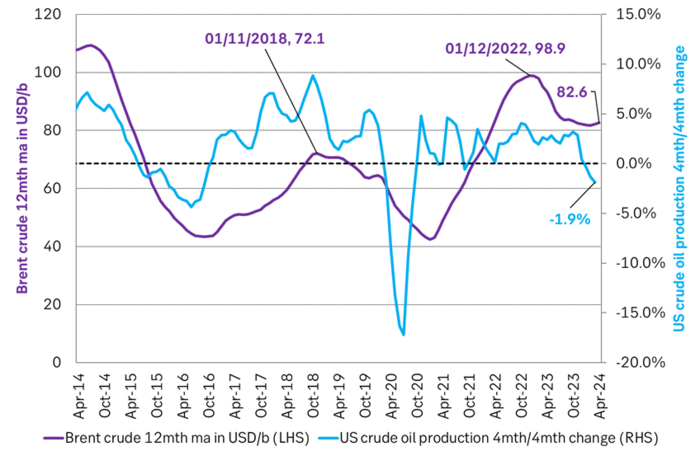
Analys
Price forecast update: Weaker green forces in the EU Parliament implies softer EUA prices


We reduce our forecast for EUA prices to 2030 by 10% to reflect the weakened green political agenda in the EU Parliament following the election for the Parliament on 6-9 June. The upcoming election in France on 7 July is an additional risk to the political stability of EU and thus in part also to the solidity of the blocks green agenda. Environmental targets for 2035 and 2040 are most at risk of being weakened on the margin. EUA prices for the coming years to 2030 relate to post-2030 EUA prices through the bankability mechanism. Lower post-2030 climate ambitions and lower post-2030 EUA prices thus have a bearish impact on EUA prices running up to 2030. Actual softening of post-2030 climate ambitions by the EU Parliament have yet to materialize. But when/if they do, a more specific analysis for the consequences for prices can be carried out.
EUA prices broke with its relationship with nat gas prices following the EU Parliament election. The EUA price has dutifully followed the TTF nat gas price higher since they both bottomed out on 23 Feb this year. The EUA front-month price bottomed out with a closing price of EUR 50.63/ton on 23 Feb. It then reached a recent peak of EUR 74.66/ton on 21 May as nat gas prices spiked. Strong relationship between EUA prices and nat gas prices all the way. Then came the EU Parliament election on 6-9 June. Since then the EUA price and TTF nat gas prices have started to depart. Bullish nat gas prices are no longer a simple predictor for bullish EUA prices.
The front-month EUA price vs the front-year TTF nat gas price. Hand in hand until the latest EU Parliament election. Then departing.
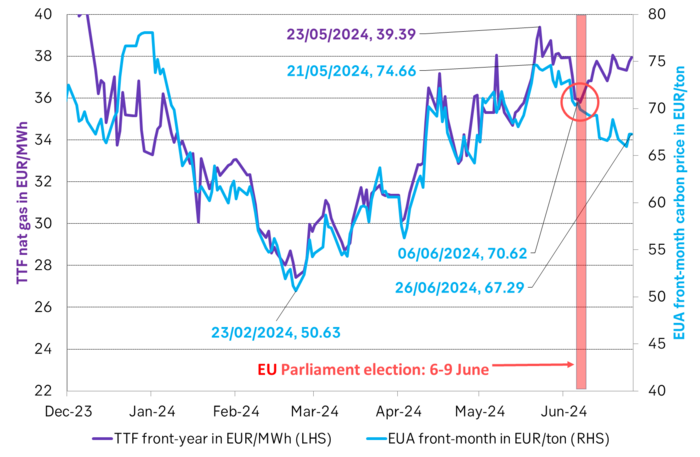
The EU Parliament election on 6-9 June was a big backlash for the Greens. The Greens experienced an euphoric victory in the 2019 election when they moved from 52 seats to 74 seats in the Parliament. Since then we have had an energy crisis with astronomic power and nat gas prices, rampant inflation and angry consumers being hurt by it all. In the recent election the Greens in the EU Parliament fell back to 53 seats. Close to where they were before 2019.
While green politics and CO2 prices may have gotten a lot of blame for the pain from energy prices over the latest 2-3 years, the explosion in nat gas prices are largely to blame. But German green policies to replace gas and oil heaters with heat pumps and new environmental regulations for EU farmers are also to blame for the recent pullback in green seats in the Parliament.
Green deal is still alive, but it may not be fully kicking any more. Existing Green laws may be hard to undo, but targets for 2035 and 2040 will be decided upon over the coming five years and will likely be weakened.
At heart the EU ETS system is a political system. As such the EUA price is a politically set price. It rests on the political consensus for environmental priorities on aggregate in EU.
The changes to the EU Parliament will likely weaken post-2030 environmental targets. The changes to the EU Parliament may not change the supply/demand balance for EUAs from now to 2030. But it will likely weaken post-2030 environmental targets and and thus projected EU ETS balances and EUA prices post-2030. And through the bankability mechanism this will necessarily impact EUA prices for the years from now to 2030.
Weaker post-2030 ambitions, targets and prices implies weaker EUA prices to 2030. EUA prices are ”bankable”. You can buy them today and hold on to them and sell them in 2030 or 2035. The value of an EUA today fundamentally rests on expected EUA prices for 2030/35. These again depends on EU green policies for the post 2030 period. Much of these policies will be ironed out and decided over the coming five years.
Weakening of post-2030 targets have yet to materialize. But just talking about it is a cold shower for EUAs. These likely coming weakenings in post-2030 environmental targets and how they will impact EUA prices post 2030 and thus EUA prices from now to 2030 are hard to quantify. But what is clear to say is that when politicians shift their priorities away from the environment and reduce their ambitions for environmental targets post-2030 it’s like a cold shower for EUA prices already today.
On top of this we now also have snap elections in the UK on 4 July and in France on 7 July with the latter having the potential to ”trigger the next euro crisis” according to Gideon Rachman in a recent article in FT.
What’s to be considered a fair outlook for EUA prices for the coming five years in this new political landscape with fundamentally changed political priorities remains to be settled. But that EUA price outlooks will be lowered versus previous forecasts is almost certain.
We reduce our EUA price forecast to 2030 by 10% to reflect the new political realities. To start with we reduce our EUA price outlook by 10% from 2025 to 2030 to reflect the weakened Green agenda in the EU parliament.
SEB’s EUA price forecast, BNEF price forecasts and current market prices in EUR/MWh
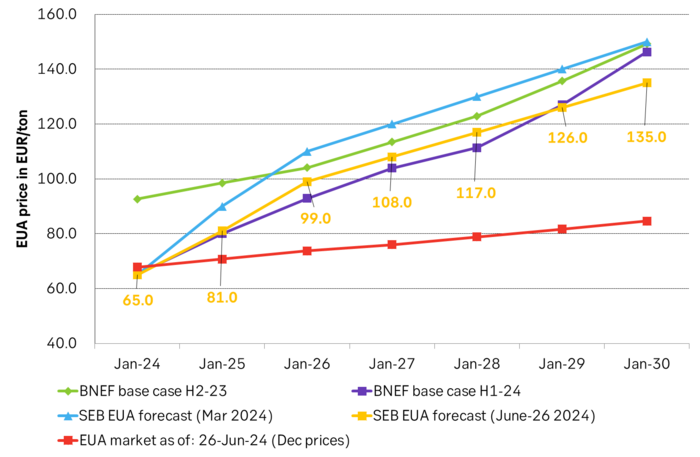
Analys
The most important data point in the global oil market will be published on Friday 28 June


US crude oil production has been booming for more than a decade. Interrupted by two setbacks in response to sharp price declines. The US boom has created large waves in the global oil market and made life very difficult for OPEC(+). Brent crude has not traded below USD 70/b since Dec-2021 and over the past year, it has averaged USD 84/b. US shale oil production would typically boom with such a price level historically. However, there has been zero growth in US crude oil production from Sep-2023 to Mar-2024. This may be partially due to a cold US winter, but something fundamentally seems to have changed. We recently visited a range of US E&P and oil services companies in Houston. The general view was that there would be zero growth in US crude oil production YoY to May 2025. If so and if it also is a general shift to sideways US crude oil production beyond that point, it will be a tremendous shift for the global oil market. It will massively improve the position of OPEC+. It will also sharply change our perception of the forever booming US shale oil supply. But ”the proof is in the pudding” and that is data. More specifically the US monthly, controlled oil production data is to be published on Friday 28 June.
The most important data point in the global oil market will be published on Friday 28 June. The US EIA will then publish its monthly revised and controlled oil production data for April. Following years of booming growth, the US crude oil production has now gone sideways from September 2023 to March 2024. Is this a temporary blip in the growth curve due to a hard and cold US winter or is it the early signs of a huge, fundamental shift where US crude oil production moves from a decade of booming growth to flat-lining horizontal production?
We recently visited a range of E&P and oil services companies in Houston. The general view there was that US crude oil production will be no higher in May 2025 than it is in May 2024. I.e. zero growth.
It may sound undramatic, but if it plays out it is a huge change for the global oil market. It will significantly strengthen the position of OPEC+ and its ability to steer the oil price to a suitable level of its choosing.
The data point on Friday will tell us more about whether the companies we met are correct in their assessment of non-growth in the coming 12 months or whether production growth will accelerate yet again following a slowdown during winter.
The US releases weekly estimates for its crude oil production but these are rough, temporary estimates. The market was fooled by these weekly numbers last year when the weekly numbers pointed to a steady production of around 12.2 m b/d from March to July while actual monthly data, with a substantial lag in publishing, showed that production was rising strongly.
The real data are the monthly, controlled data. These data will be the ”proof of the pudding” of whether US shale oil production now is about to shift from a decade of booming growth to instead flat-line sideways or whether it will drift gradually higher as projected by the US EIA in its latest Short-Term Energy Outlook.
US crude oil production given by weekly data and monthly data. Note that the monthly, controlled data comes with a significant lag. The market was thus navigating along the weekly data which showed ”sideways at 12.2 m b/d” for a significant period last year until actual data showed otherwise with a time-lag.
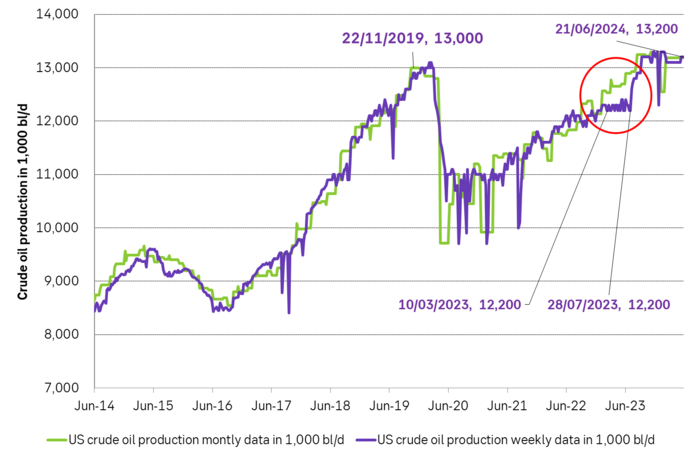
If we add in Natural Gas Liquids and zoom out to include history back to 2001 we see an almost uninterrupted boom in supply since Sep 2011 with a few setbacks. At first glance, this graph gives little support to a belief that US crude oil production now suddenly will go sideways. Simple extrapolation of the graph indicates growth, growth, growth.
US crude and liquids production has boomed since September 2011
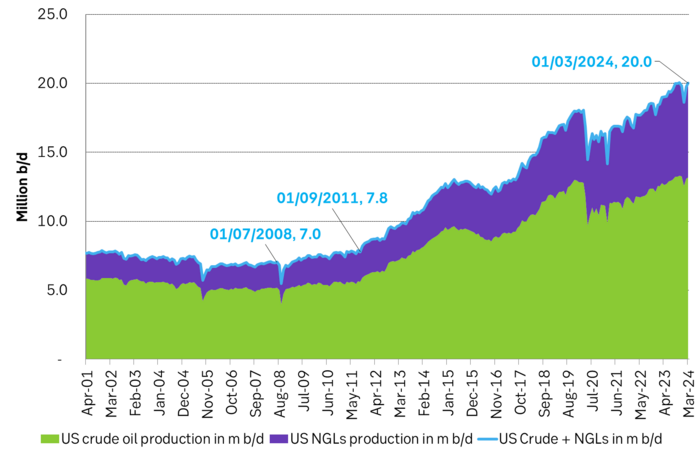
However. The latest actual data point for US crude oil production is for March with a reading of 13.18 m b/d. What stands out is that production then was still below the September level of 13.25 m b/d.
The world has gotten used to forever growing US crude oil production due to the US shale oil revolution, with shorter periods of sharp production declines as a result of sharp price declines.
But the Brent crude oil price hasn’t collapsed. Instead, it is trading solidly in the range of USD 70-80-90/b. The front-month Brent crude oil contract hasn’t closed below USD 70/b since December 2021.
Experiences from the last 15 years would imply wild production growth and activity in US shale oil production at current crude oil prices. But US crude oil production has now basically gone sideways to lower from September to March.
The big, big question is thus: Are we now witnessing the early innings of a big change in US shale oil production where we shift from booming growth to flat-lining of production?
If we zoom in we can see that US liquids production has flat-lined since September 2023. Is the flat-lining from Sep to Mar due to the cold winter so that we’ll see a revival into spring and summer or are we witnessing the early signs of a huge change in the global oil market where US crude oil production goes from booming growth to flat-line production.

The message from Houston was that there will be no growth in US crude oil production until May 2025. SEB recently visited oil and gas producers and services providers in Houston to take the pulse of the oil and gas business. Especially so the US shale oil and shale gas business. What we found was an unusually homogeneous view among the companies we met concerning both the state of the situation and the outlook. The sentiment was kind of peculiar. Everybody was making money and was kind of happy about that, but there was no enthusiasm as the growth and boom years were gone. The unanimous view was that US crude oil production would be no higher one year from now than it is today. I.e. flat-lining from here.
The arguments for flat-lining of US crude oil production here onward were many.
1) The shale oil business has ”grown up” and matured with a focus on profits rather than growth for the sake of growth.
2) Bankruptcies and M&As have consolidated the shale oil companies into larger, fewer public companies now accounting for up to 75% of total production. Investors in these companies have little interest/appetite for growth after having burned their fingers during a decade and a half of capital destruction. These investors may also be skeptical of the longevity of the US shale oil business. Better to fully utilize the current shale oil infrastructure steadily over the coming years and return profits to shareholders than to invest in yet more infrastructure capacity and growth.
3) The remaining 25% of shale oil producers which are in private hands have limited scope for growth as they lack pipeline capacity for bringing more crude oil from field to market. Associated nat gas production is also a problem/bottleneck as flaring is forbidden in many places and pipes to transport nat gas from field to market are limited.
4) The low-hanging fruits of volume productivity have been harvested. Drilling and fracking are now mostly running 24/7 and most new wells today are all ”long wells” of around 3 miles. So hard to shave off yet another day in terms of ”drilling yet faster” and the length of the wells has increasingly reached their natural optimal length.
5) The average ”rock quality” of wells drilled in the US in 2024 will be of slightly lower quality than in 2023 and 2025 will be slightly lower quality than 2024. That is not to say that the US, or more specifically the Permian basin, is quickly running out of shale oil resources. But this will be a slight headwind. There is also an increasing insight into the fact that US shale oil resources are indeed finite and that it is now time to harvest values over the coming 5-10 years. One company we met in Houston argued that US shale oil production would now move sideways for 6-7 years and then overall production decline would set in.
The US shale oil revolution can be divided into three main phases. Each phase is probably equally revolutionary as the other in terms of impact on the global oil market.
1) The boom phase. It started after 2008 but didn’t accelerate in force before the ”Arab Spring” erupted and drove the oil price to USD 110/b from 2011 to 2014. It was talked down time and time again, but it continued to boom and re-boom to the point that today it is almost impossible to envision that it won’t just continue to boom or at least grow forever.
2) The plateau phase. The low-hanging fruits of productivity growth have been harvested. The highest quality resources have been utilized. The halfway point of resources has been extracted. Consolidation, normalization, and maturity of the business has been reached. Production goes sideways.
3) The decline phase. Eventually, the resources will have been extracted to the point that production unavoidably starts to decline.
Moving from phase one to phase two may be almost as shocking for the oil market as the experience of phase 1. The discussions we had with oil producers and services companies in Houston may indicate that we may now be moving from phase one to phase two. That there will be zero shale oil production growth YoY in 2025 and that production then may go sideways for 6-7 years before phase three sets in.
US EIA June STEO report with EIA’s projection for US crude oil production to Dec-2025. Softer growth, but still growth.
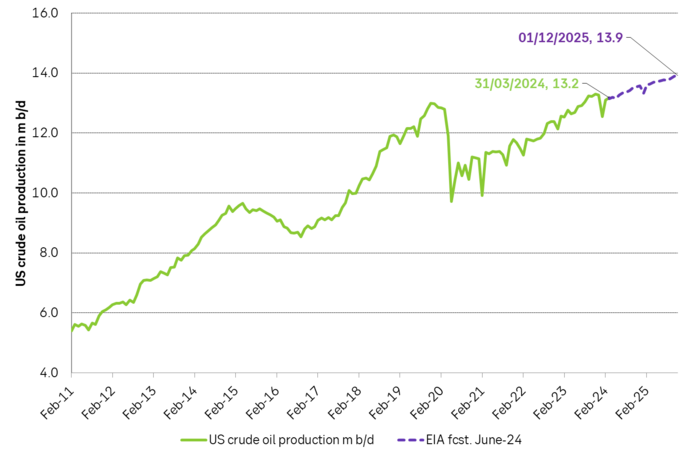
US EIA June STEO report with YoY outlook growth for 2025. Projects that US crude production will grow by 0.47 m b/d YoY in 2025 and that total liquids will grow by 720 k b/d YoY.
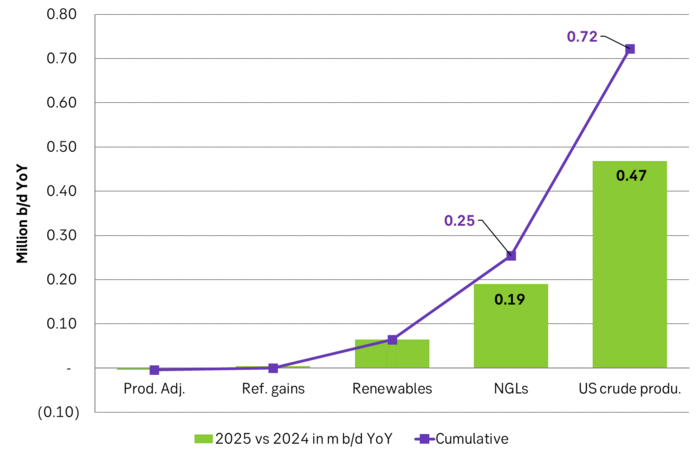
US EIA June STEO report with outlook for production growth by country in 2025. This shows how big the US production growth of 0.7 m b/d YoY really is compared to other producers around the world
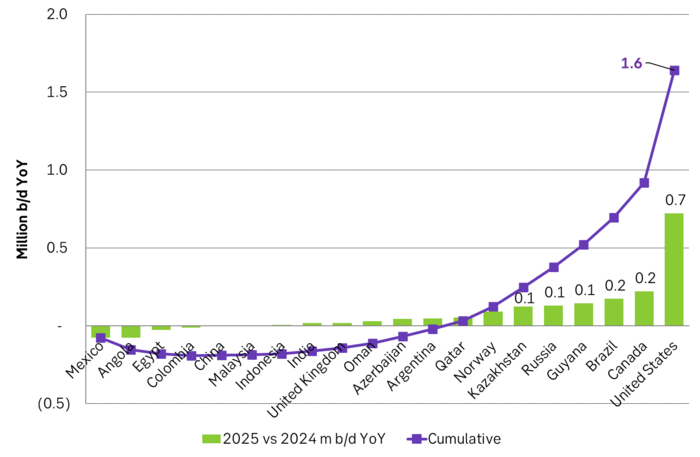
US EIA June STEO report with projected global growth in supply and demand YoY in 2025. Solid demand growth, but even strong supply growth with little room for OPEC+ to expand. Production growth by non-OPEC+ will basically cover global oil demand growth.
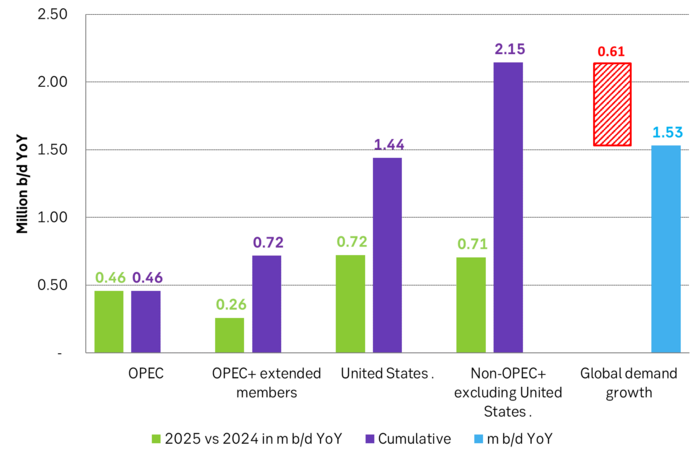
But if there instead is zero growth in US crude oil production in 2025 and the US liquids production only grows by 0.25 m b/d YoY due to NGLs and biofuels, then suddenly there is room for OPEC+ to put some of its current production cuts back into the market. Thus growth/no-growth in US shale oil production will be of huge importance for OPEC+ in 2025. If there is no growth in US shale oil then OPEC+ will have a much better position to control the oil price to where it wants it.
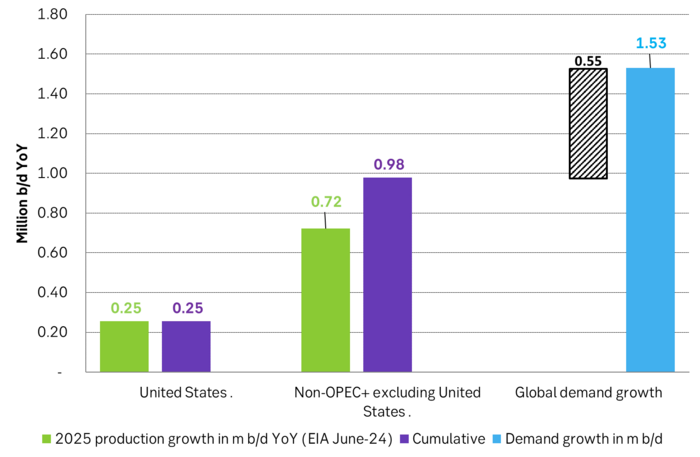
US crude oil production and drilling rig count
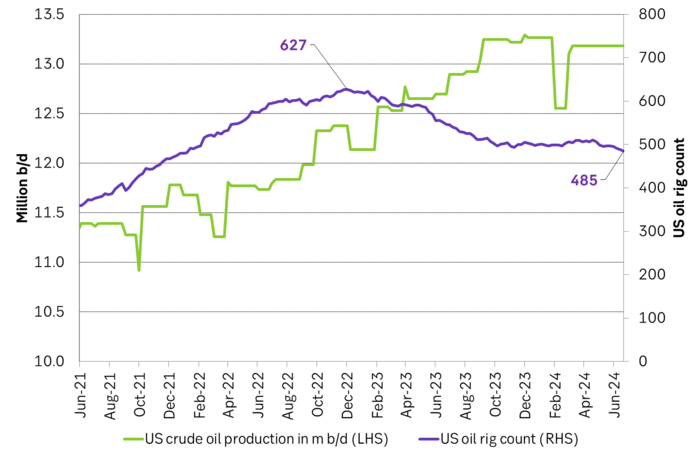
-

 Nyheter1 vecka sedan
Nyheter1 vecka sedanDe tre bästa råvaruvaruaktierna just nu
-

 Nyheter2 veckor sedan
Nyheter2 veckor sedanLundin Mining vill köpa Filo Corp tillsammans med BHP
-

 Nyheter4 veckor sedan
Nyheter4 veckor sedanAfrica Oil är bra att köpa anser Stifel som inleder analysbevakning
-
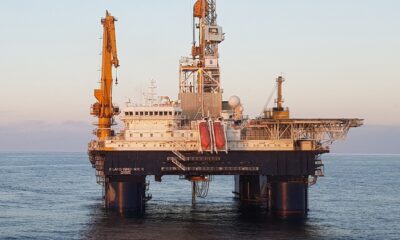
 Nyheter3 veckor sedan
Nyheter3 veckor sedanStor risk att Africa Energy inte överlever det kommande året
-
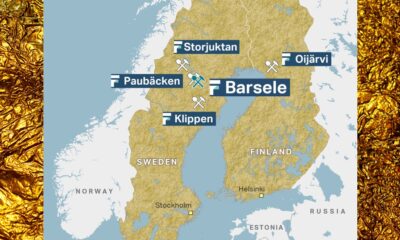
 Nyheter4 veckor sedan
Nyheter4 veckor sedanFirst Nordic Metals har fyra prospekteringsprojekt i Sverige
-

 Analys4 veckor sedan
Analys4 veckor sedanBrent crude inching higher on optimism that US inflationary pressures are fading
-

 Nyheter2 veckor sedan
Nyheter2 veckor sedanUniper satsar på att göra elektrobränsle av sin elektricitet
-

 Nyheter2 veckor sedan
Nyheter2 veckor sedanTre bra aktier inom olja och oljeservice i Kanada


